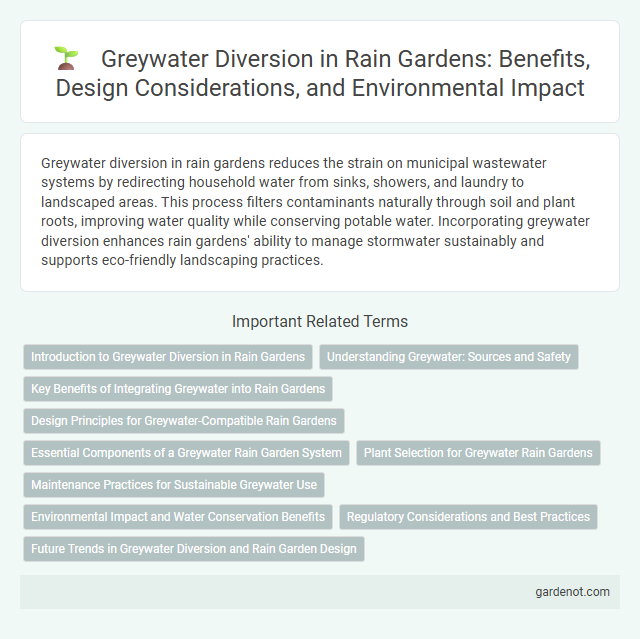Greywater diversion in rain gardens reduces the strain on municipal wastewater systems by redirecting household water from sinks, showers, and laundry to landscaped areas. This process filters contaminants naturally through soil and plant roots, improving water quality while conserving potable water. Incorporating greywater diversion enhances rain gardens' ability to manage stormwater sustainably and supports eco-friendly landscaping practices.
Introduction to Greywater Diversion in Rain Gardens
Greywater diversion in rain gardens involves redirecting lightly used household water, such as from sinks and showers, into landscaped areas for natural filtration and reuse. This practice reduces freshwater consumption and limits stormwater runoff by utilizing greywater to irrigate plants within the rain garden system. Incorporating greywater diversion enhances rain garden efficiency by promoting groundwater recharge and improving urban water management.
Understanding Greywater: Sources and Safety
Greywater, originating from household sources such as sinks, showers, and laundry, excludes sewage and toilet discharge, making it suitable for rain garden irrigation when properly managed. Understanding greywater safety involves recognizing its potential contaminants, including soap, grease, and pathogens, which require treatment or natural filtration to prevent soil and water pollution. Effective greywater diversion enhances water conservation by reducing freshwater demand and supporting sustainable rain garden ecosystems.
Key Benefits of Integrating Greywater into Rain Gardens
Integrating greywater into rain gardens enhances water conservation by reducing demand on freshwater supplies and lowering stormwater runoff, which mitigates urban flooding. This process promotes natural filtration as greywater passes through soil and plants, improving water quality before it recharges groundwater. Utilizing greywater also supports sustainable landscaping by providing a consistent moisture source, reducing irrigation needs and promoting healthier plant growth.
Design Principles for Greywater-Compatible Rain Gardens
Design principles for greywater-compatible rain gardens emphasize selecting appropriate native plants that tolerate variable moisture and nutrient levels associated with greywater. Soil media must be engineered for optimal infiltration and biofiltration, balancing permeability with contaminant removal to prevent groundwater contamination. Incorporating an underdrain system and pretreatment stages enhances the garden's capacity to manage greywater safely and effectively within urban stormwater management frameworks.
Essential Components of a Greywater Rain Garden System
A greywater rain garden system integrates essential components such as a diverter valve to redirect greywater from household sources like sinks and showers into the garden, where engineered soil layers and native plants naturally filter and absorb contaminants. Perforated piping and sedimentation basins ensure controlled water flow and prevent clogging by capturing solids before infiltration. This system optimizes greywater reuse, promoting water conservation while enhancing stormwater management and supporting healthy ecological function within urban landscapes.
Plant Selection for Greywater Rain Gardens
Selecting drought-tolerant and salt-tolerant plants such as lavender, ornamental grasses, and sedums enhances the efficiency of greywater rain gardens by thriving in nutrient-rich, occasionally saline conditions. Native species with deep root systems like switchgrass and blue flag iris improve infiltration and pollutant uptake, ensuring optimal greywater absorption and filtration. Choosing plants with high pollutant tolerance and low maintenance needs reduces system clogging and promotes sustainable water recycling in urban landscapes.
Maintenance Practices for Sustainable Greywater Use
Effective maintenance practices for greywater diversion in rain gardens include regular inspection and cleaning of filters and distribution systems to prevent clogging and ensure optimal water flow. Monitoring soil moisture levels and vegetation health helps maintain the garden's ability to treat greywater sustainably. Routine removal of debris and sediment buildup enhances system longevity and protects water quality for reuse.
Environmental Impact and Water Conservation Benefits
Greywater diversion in rain gardens significantly reduces freshwater demand by capturing and reusing household wastewater for irrigation, promoting sustainable water management. This practice lowers nutrient and pollutant loads entering stormwater systems, improving local water quality and supporting aquatic ecosystems. Implementing greywater systems enhances groundwater recharge and mitigates urban runoff, contributing to climate resilience and biodiversity conservation.
Regulatory Considerations and Best Practices
Greywater diversion for rain gardens must comply with local and state regulations governing water reuse, which often include restrictions on the types of greywater sources allowed and treatment standards. Best practices emphasize proper system design to prevent contamination, such as using filtration and routing greywater away from potable water supplies and avoiding contact with edible plants. Regular maintenance protocols and clear labeling of greywater lines are essential to meet health codes and ensure long-term operational safety.
Future Trends in Greywater Diversion and Rain Garden Design
Future trends in greywater diversion emphasize integrating smart sensors and automation to optimize water reuse efficiency within rain garden designs. Innovations in biodegradable filtration media and adaptive landscaping methods are enhancing pollutant removal and improving plant health in greywater-fed rain gardens. These advancements support sustainable urban water management by maximizing water recycling and minimizing stormwater runoff.
Greywater diversion Infographic

 gardenot.com
gardenot.com